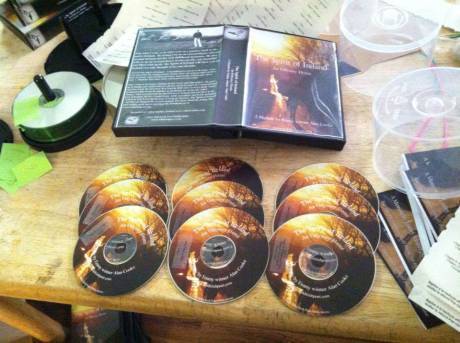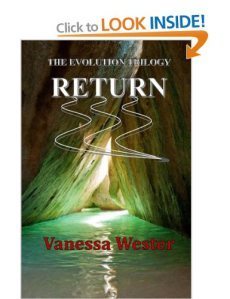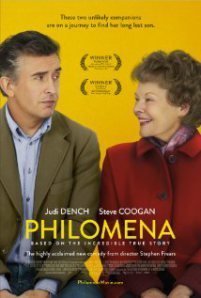Olga Núñez Miret's Blog: Author Translator Olga, page 111
December 2, 2013
Review of The Spirit of Ireland — An Odyssey Home —Ireland Memoir. Audiobook by Alan Cooke (a.k.a Irish Wild Poet: http://wildirishpoet.com/). A truly inspiring voyage
I recently finished listening to the audio of The Spirit of Ireland by Alan Cooke. I had listened (and read) Naked in New York where the author explores his adventures and experiences in New York, that I’ve reviewed in the past and again recommend. I’ve also watched his movie Home that I feel is a good companion piece of Naked and has the advantage of documenting Cooke’s personal journey whilst incorporating the views of New Yorkers old and young, famous and unknown, native and immigrants. He well deserves the Emmy for his writing in the film and I am at a loss to account for the lack of distribution for it.
The author, an Irish actor, now turned writer, voice coach, and creator of audio and video sketches, returned to Ireland after his visit to the US. The Spirit of Ireland is his memoir of the process of rediscovering his country, his nation, his culture, and himself. In some ways it picks up from where Naked left, but in my opinion it goes further and deeper than the previous book.
Mr Cooke combines purely autobiographical episodes (I find his remembrances of childhood scenes particularly touching) with passages where he sets his spiritual/real travels. In his trips to places known (his parents’ house, villages they used to visit when he was a child) he notes the changes experienced, the contrast between his expectations, built through years of dreaming about “home” from afar, and the sometimes stark reality. He also observes the changes inside, and how he sees and feels differently now.
In his travels to new places, places that call to him, he feels at times a communion with the elements, with the spirit and soul of Ireland that he embraces fully.
His descriptions of quasi-mythical animals (the horse that visits his house and seems to symbolise the untamed Celtic s spirit of the island), of primeval landscapes (that reflect the magical and ancestral power of the land), of people and faces will touch you, even if you, like me, have not a drop of Irish blood running through your veins. The author seems to tap into something that is at the same time profoundly personal but also universal, and through his voice he takes us to a place that is wondrous, exhilarating, frightening and raw. A place where we have to confront ourselves, and if we survive, we’ll finally be Home. I wonder if this is what Carl Jung was talking about when he referred to the Collective Unconscious.
The collective unconscious – so far as we can say anything about it at all – appears to consist of mythological motifs or primordial images, for which reason the myths of all nations are its real exponents. In fact, the whole of mythology could be taken as a sort of projection of the collective unconscious… We can therefore study the collective unconscious in two ways, either in mythology or in the analysis of the individual. (From The Structure of the Psyche, CW 8, par. 325.)
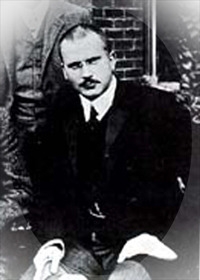
Carl-Jung-mod (Photo credit: Wikipedia)
Having visited a tiny bit of West Ireland a few months ago I recognised some of the descriptions (loved the Isles of Aran and adored CD 4). I could also identify with some of the experiences (I remember my thoughts during my First Communion too). I gladly accompanied him on his visits and would love to meet the many characters he comes across, that always have stories to tell and help create a quilt of experiences and voices to illustrate the nature of the place and its people. The author, a bard and raconteur, is narrator, protagonist, interpreter, and performer. He has said in interviews that above all he is a performer and he can connect and communicate with people live in ways he feels is not possible by writing on the page. I feel he is too modest, although I must admit that the combination of the words with his voice and reading makes it irresistible. (And I take the opportunity to recommend some of his other audios too [A Christmas Carol, De Profundis, Oscar Wilde’s Fairy Tales…]. You might not want to listen to anybody else’s work after that but…).
The memoir genre has become oversubscribed. Sometimes it feels as if everybody wants to write one or has written one. Don’t worry, though. This is not your standard memoir. Although the author shares very personal and even intimate experiences (the image of his mother’s reaction when she heard of the death of her own mother, the author’s grandmother, run over by a lorry will stay with me forever), it never becomes an exercise in self-indulgence. He is the consciousness of that spirit, and you won’t get any gossip or know the everyday details of life in the Burren. I leave you a link to an interesting article posted at BerkeleyUniversity on memoirs. According to Christopher Booker’s seven basic plots, The Spirit of Ireland probably falls within the plots of ‘quest’ (Odyssey being a very apt word), ‘voyage and return’ and ‘rebirth’. And if we look at William Grimes’s article: ‘We All Have A Life. Must We All Write About It?’ it would probably fall somewhere between ‘the spiritual-journey memoir’ and ‘the spirit of place memoir’. It is all of that and more. If you want to go to places you haven’t been, get in touch with your own spirituality, and connect with collective myths, whilst listening to a beautiful and engrossing voice, I recommend you the audio of The Spirit of Ireland.
Mr Cooke sells all his work through his own website, here:
There you will also find links to his Facebook pages (where you can follow his posts, including samples of new work, photographs, etc.), his e-mail address if you want to contact him, and you can also access updates on his projects.
Thank you for reading and as if you’ve enjoyed it, remember to like, comment, share and of course CLICK!
This is the link to the article on memoirs:
http://ist-socrates.berkeley.edu/~kihlstrm/memoir.htm
Related articles
The Spirit of Ireland – An Odyssey Home – Audio Book Launch and live performance with Alan Cooke (celticmusicfan.com)
Psychology in Writing: The Collective Unconscious – Introduction (wtjowett.wordpress.com)








November 28, 2013
Autora Clásica Invitada. Emilia Pardo Bazán. Naturalismo y Realismo en la literatura española
Como la mayoría de los viernes, os traigo una escritora clásica. Hoy es a sugerencia de Xan, uno de los miembros del grupo Café Literario en Goodreads, que comentó sobre uno de mis previos posts (el de Rosalía de Castro), y aquí os la traigo porque me pareció una sugerencia fabulosa, y porque quería aprender más sobre ella. Emilia Pardo Bazán.
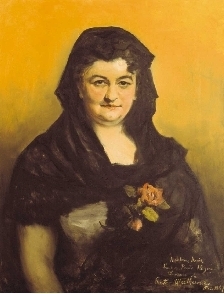
Emilia Pardo Bazán (Photo credit: Wikipedia)
Como suelo, primero os presento una breve biografía (más abajo os dejo enlaces donde podéis encontrar más detalles) y luego enlaces gratuitos a sus obras.
Biografía:
Emilia Pardo Bazán nació en La Coruña el 16 de Septiembre de 1851, de familia aristocrática gallega (su padre era Conde y ella heredó el título a su muerte). Su padre era un político liberal y la familia se aseguró de que Pardo Bazán tuviera una muy buena educación y fomentaron su interés por la literatura. Desde los 9 años empezó a escribir. La familia tenía varias residencias, una en un pueblo de pescadores cerca de Sanjenjo y una en las afueras de La Coruña, el Pazo de Meirás. Leyó mucho y comentaba que sus obras favoritas de juventud fueron Don Quijote, la Biblia y la Ilíada. La familia iba a Madrid durante los inviernos, donde ella acudió a un colegio francés, y Pardo Bazán aprendió francés y empezó a leer muchos de los clásicos franceses. Ella se negó a seguir los dictados de la educación de señoritas de buena familia y se negó a aprender el piano o a estudiar música, dedicando todo el tiempo que podía a leer.

gl:Pazo de Meirás – - Sada – A Coruña (Photo credit: Wikipedia)
A los 17 años se casó con José Quiroga Pérez Deza, que se dedicaba a la política. Se trasladaron a Madrid, y cuando fue elegido diputado el resto de la familia se les unió. Cuando se desilusionó de la política la familia se fue de viaje, primero a Francia y luego por toda Europa (Inglaterra, Italia, Alemania) donde Pardo Bazán aprendió también el alemán y el inglés. Publicó crónicas del viaje y más tarde libros, proponiendo que era necesario europeizar España y sugiriendo viajar como medio de educación.
Ganó un premio en competición directa con Concepción Arenal con Estudio crítico de las obras del padre Feijoo (1876). En el mismo año nace su primer hijo al que le dedica un libro de poemas Jaime. En 1879, el año en que nació su hija Blanca, publicó su primera novela, Pascual López (autobiografía ficticia de un estudiante de medicina… tendría que leerla yo). Tuvo éxito y la llevó a seguir escribiendo, aunque aún no había desarrollado el estilo que la haría conocida.
En 1882 empezó a publicar en la revista La Época una serie de artículos sobre Zola que luego fueron reunidos en La cuestión palpitante (1883) que la hizo ganar la reputación de impulsora del naturalismo en España. La obra trajo mucha controversia ya que se vio como una obra a favor de la pornografía francesa y de la literatura atea, aún más grave al ser mujer. Su marido insistió en que dejara de escribir y se retractara públicamente pero ella no lo hizo y se separó de su marido al año siguiente. En 1884 publicó La dama joven sobre crisis matrimoniales. Empezó una relación amorosa con Benito Pérez Galdós (que se merece un post propio, desde luego) que duraría más de veinte años. (Por lo que leo por lo visto ella tuvo otros amoríos con jóvenes escritores como Narcís Oller). Su estilo de naturalismo, al igual que el de Galdós tenía características típicamente españolas, incluyendo el catolicismo (que nunca abandonó), y es más conservadora, aunque admite los principios del determinismo social y darwinismo. Su obra maestra es Los pazos de Ulloa.

Benito Pérez Galdós, by Joaquín Sorolla (Photo credit: Wikipedia)
Su obra de ensayos y periodismo incluye su lucha por la emancipación de la mujer, escribiendo artículos y dando conferencias sobre el tema. Su posición le ganó enemistades de otros escritores (hombres)… Suena a envidia, de verdad.
Su obra se volvió mas simbolista y espiritual cuando murió su padre (Una cristiana, La prueba, La quimera). Escribió muchos cuentos y creó una revista El Nuevo Teatro Crítico.
En 1892 funda y dirige la publicación de La Biblioteca de la mujer. Denuncia la desigualdad en la educación de las mujeres. Como exponente de ello su propuesta de Concepción Arenal a la Real Academia de la Lengua es rechazada (tampoco aceptaron a Gertrudis Gómez de Avellaneda ni a Pardo Bazán que fue nominada 3 veces). En 1906 fue la primera mujer presidente de la sección de literatura del Ateneo de Madrid, y la primera que ocupó la cátedra de literaturas neolatinas en la Universidad Central de Madrid, aunque solo un estudiante acudió a clase.
También escribió obras de teatro, libros de viajes, biografías…Más recientemente publicaron su primera novela (escrita cuando tenía 13 años) Aficiones peligrosas y descubrieron una novela inédita, Selva.
Murió en Madrid el 12 de Mayo de 1921, de una gripe que complicó su diabetes.
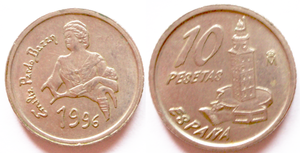
10 pesetas 1996 emilia pardo bazan (Photo credit: Wikipedia)
(Aquí podéis observar la devaluación de la moneda y quizás el sexismo (?). A Gustavo Adolfo Bécquer le dedicaron un billete de 100 pesetas. A Emilia Pardo Bazán una moneda de 10 pesetas).
Enlaces:
Biografía e información:
Wikipedia:
http://es.wikipedia.org/wiki/Emilia_Pardo_Baz%C3%A1n
Su portal en la Biblioteca virtual Cervantes:
http://www.cervantesvirtual.com/portales/pardo_bazan/
Biografías y vidas:
http://www.biografiasyvidas.com/biografia/p/pardo_bazan.htm
Escritores.org:
https://www.escritores.org/biografias/451-emilia-pardo-bazan
Un documental de RTVE (2009) sobre Emilia Pardo Bazán:
La casa-museo de Emilia Pardo Bazán (que contiene la sede de la Real Academia de la Lengua Gallega):
http://www.museosdeescritores.com/ESP_II/autor/pardobazan.htm
Y la casa-museo en Galego:
http://www.casamuseoemiliapardobazan.org/
Por lo visto van a digitalizar algunas de sus obras, por fin:
Swarthmore:
http://www.swarthmore.edu/Humanities/mguardi1/espanol_11/pardobazan.htm
Video sobre su vida y obra literaria en You Tube:
http://www.youtube.com/watch?v=SYTxkI0wk3k
Enlaces gratuitos a su obra:
Su catálogo en la biblioteca Cervantes (Incluye Los pazos de Ulloa editado por Ana María Freire):
http://www.cervantesvirtual.com/portales/pardo_bazan/catalogo/
He encontrado muchas de sus obras gratis en Amazon, pero no estoy segura de que se puedan obtener en todas las tiendas (en .com, co.uk y .es sí, pero por probar)…Si queréis ir a vuestra tienda solo hace falta cambiar .com por el sufijo correspondiente (.es para España, .mx para México…)
Os dejo unas cuantas:
Reconciliados:
http://www.amazon.com/dp/B006E9RD9C/
Cuentos de Navidad y Año Nuevo (por la época del año):
http://www.amazon.com/dp/B006E9IAOY/
Cuentos del terruño:
http://www.amazon.com/dp/B006EAGT46/
Historias y cuentos de Galicia:
http://www.amazon.com/dp/B006E9Q820/
Los pazos de Ulloa:
http://www.amazon.com/dp/B006EA5GJU/
Un viaje de novios:
http://www.amazon.com/dp/B004UJB9K2/
Hay algunas obras de las que parece que existan varias versiones en Amazon…
24 Symbols también ofrece sus obras en lectura gratuita en el Internet:
http://www.24symbols.com/author/emilia-pardo-bazan?id=64
Obras completas en varios formatos:
https://archive.org/details/obrascompletas03pard
Este es el enlace a la serie de Los pazos de Ulloa (que recuerdo bien) en IMDB. Por lo visto está a la venta en Amazon, pero supongo que también estará disponible en otros sitios.
http://www.imdb.com/title/tt0089787/?ref_=nm_flmg_wr_1
Gracias por la sugerencia a Xan, por leer a todos, y si os ha gustado, acordaos de dadle al me gusta, comentad, compartid, y haced CLIC (¡que es gratis!) Y por cierto si tenéis más sugerencias…soy toda oídos.








Guest author. Vanessa Wester and her Evolution Trilogy
It’s Friday today and we have an author guest. This time we have a familiar face. Vanessa Wester has been a guest in my blog before, but this time she’s coming to tell us about her now complete Evolution Trilogy and how she came to write it. Without further ado, I leave you with Vanessa Wester!
Ever since I started writing The Evolution Trilogy, I have worked really hard to take my baby to childhood then adulthood… I hope it can now go out into the world with its head held high.
A lot of the Trilogy has been based on some of my experiences when arriving at university in the UK as a foreigner (colonial), from my swimming days as a teen, my experiences as an adult, and my upbringing on the Rock of Gibraltar. BUT, a huge amount has come from my warped imagination…
When I found out I was pregnant again in 2008, on the same week I received my contract to return back to my teaching job after 7 years, I was convinced it would be a nightmare. My first two children were born 18 months apart and I had struggled with weight gain, depression, an under-active thyroid, loneliness, and the rest that comes with becoming a new parent…
My cousin also passed away aged 27 from a brain tumour, and other events happened to close family members that broke my heart. These made me reflect on my own life all the time, and I did not feel I had the right to complain about any hardships I faced. What could be worse than losing your life?
However, we all have the right to “suffer” and obtain sympathy for whatever makes us feel down. The characters in my trilogy encounter many difficulties, and I guess in a fictional setting it is easier to make things happen and talk about things that effect us all. The science fiction idea is complete fantasy, and the use of vampires is all for fun.
What I have learnt is that in life things happen for a reason. I have enjoyed every minute of being a parent for the third time. I was so much more relaxed, had fun with my daughter, and balanced three kids with some grace (most of the time… ha ha ha). It was whilst I sat watching my daughter at home that I started to write on a notepad, then progressed to a laptop, then computer… Once I caught the writing bug nothing stopped me and I became obsessed for a while. Every time my daughter slept, I wrote.
I bought a copy of the Writers & Artists handbook and tried to figure out the submissions process. I joined The Word Cloud, read a lot, and learnt to take critique. Then I saw the posts by David Gaughran, who wrote Let’s Get Digital on the Cloud… and decided to go for it and self publish. It took me months to figure out the process of ebook publishing, using the advice on smashwords. I quickly realised Amazon was where a lot of readers bought books – the dominance of the kindle! So, off to Amazon I went… Don’t even get me started on the paperback formatting!
When I was gifted an iPad by my father in law (thank you) my life changed. Social media became easier to use…
Now, I don’t want to bore you… I should write a book about this!
The point is… had I not got pregnant I would never have started writing books. As a child I dreamed of being a writer, but the fact I was scientifically minded made me abandon the dream as the years went by. Yet, the fusion of my interests and dreams has led me to write this Trilogy.
Like I say on my catch line… In the game of life, destiny is the winner
Anyway, my Trilogy is suitable for mature readers of about 10ish and above (my daughter is a fan – aged 9!). In addition, my books have been enjoyed by both men and women of all ages, to my huge surprise, so I hope some of you decide to give them a go.
My latest reviewer said:
“A great set of books. A must read for all. Imaginative story somehow believable. I would like to visit the community myself.”
Thank you for reading, and thank you, Olga, for hosting me on your site.
Vanessa  xx
xx
Thanks Vanessa. It was a pleasure to have you as guest again, and I hope you’ll visit us with news soon. I leave you links to Vanessa’s works and blogs:
www.theevolutiontrilogy.blogspot.com
www.vanessawesterwriter.blogspot.com
Here a link to her previous guest post. And of course, as always, thanks for reading and if you’ve enjoyed it, don’t forget to like, comment, share and CLICK!
http://olganm.wordpress.com/2012/12/07/guest-author-vanessa-wester/








November 25, 2013
Reseña de película. Philomena (Judi Dench, Steve Coogan, Dir: Stephen Frears)
Philomena es la adaptación del libro de Martin Sixsmith (intepretado por Steve Coogan) que cuenta la historia de Philomena Lee (Judi Dench), una mujer irlandesa que se quedó embarazada, su familia la echó de casa y acabó en un convento donde tuvo que trabajar (siete días por semana en los trabajos más duros) durante cuatro años para obtener el privilegio de poder ver a su hijo una hora al día, y cuyo hijo fue adoptado. Ahora (2002) que su hijo cumpliría cincuenta años le cuenta la historia a su hija, quien se la cuenta a Martin (a quien han ‘resignado’ de su puesto de spin doctor, después de muchos años como corresponsal de la BBC y periodista político). Al principio él tacha la historia de puro “interés personal”, por debajo de sus habilidades e intereses (está empeñado en escribir un libro sobre historia rusa que parece no interesarle a nadie), pero al final decide hacerlo.
Aunque no he leído el libro, Steve Coogan, que también ha escrito el guion, ha hecho un gran trabajo, por un lado contando el desarrollo interior de los dos personajes, y por otro haciendo que su interacción y la relación entre ambos se convierta en el corazón de la historia.
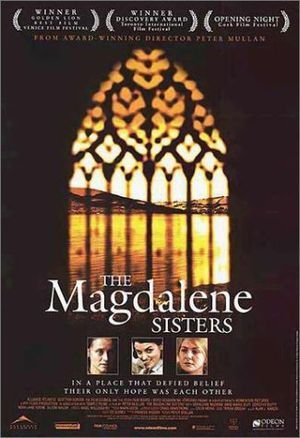
The Magdalene Sisters (Photo credit: Wikipedia)
El fondo histórico de la novela (una historia real) ha sido contado en otras ocasiones (Las hermanas de la Magdalena, En el nombre de Dios). Es difícil creer que cualquier credo religioso pudiera usarse para encarcelar a mujeres y separarlas de sus hijos, por pecados cometidos. Y cuando nos enteramos de que encima cobraban por las adopciones, es aún peor. El personaje de Sor Hildegard en la película representa la personificación de lo peor de la religión, y el hecho de que Philomena sea amable y comprensiva con ella la transforma en un personaje aún más ejemplar y generosa de espíritu.
En lo que Philomena se diferencia de otras películas con temas similares es en como enfoca al personaje principal. La película nos muestra las dudas y ambivalencia de esta mujer, que sigue siendo muy religiosa, devota de la fe Católica, y que continuamente subvierte las expectativas de Martin, que la ve como una mujer mayor de poco entendimiento y sutileza. Al final él llega a apreciar su resistencia, su generosidad y su actitud abierta y comprensiva. Y como en las mejores relaciones, los dos cambian y crecen como personas al conocerse.
¿Es una película triste? Bueno, la historia es triste, la realidad histórica reflejada por la película es terrible e indignante (y es hora de que se haga algo oficial para ayudar a esas madres a encontrar a sus hijos), pero el balance entre momentos tristes y divertidos, la maravillosa interacción entre los personajes, y la personalidad y actitud de Philomena la convierten en inspiradora y optimista.
Me encanta Judi Dench y aquí está perfecta y tan desinteresada y generosa como siempre. Quiero mucho a mi madre pero con mucho gusto adoptaría a su personaje como madre. Steve Coogan demuestra que también puede interpretar personajes serios de forma impecable, y su guion es fantástico. Y viendo la película uno sospecha que su creación debió ser toda una experiencia. Por supuesto Stephen Frears es un gran director y presenta la historia sin exageraciones estilísticas innecesarias ni otras distracciones.
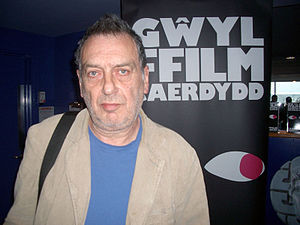
Stephen Frears at the 2006 Cardiff Film Festival. (Photo credit: Wikipedia)
Recomiendo Philomena de corazón. Os hará pensar, miraréis a vuestra familia con otros ojos, y os hará sentiros mejor.
Y si os interesa ver alguna otra historia de adopciones injustas y desarraigo, os recomiendo Naranjas y sol (Oranges and Sunshine) y Generación robada/Cerca de la libertad.
Gracias por leer, y si os ha gustado no os olvidéis de darle al me gusta, comentar y compartir. ¡E ir a verla!
Related articles
Steve Coogan and Philomena Lee on “Philomena” (wnyc.org)
Philomena is a heartbreaking masterpiece, with Judi Dench and Steve Coogan on top form (metro.co.uk)
‘Philomena’ Review (sroutledge.wordpress.com)
‘Philomena’ gets its R rating lowered to PG-13 (latimes.com)
Philomena (thing) (everything2.com)








Film Review. Philomena (Dame Judi Dench, Steve Coogan, Dir: Stephen Frears)
Philomena is a film adaptation of a book by Martin Sixsmith (played by Steve Coogan in the movie) narrating the story of Philomena Lee (played by Judi Dench), an Irish woman who got pregnant, was disowned by her family and ended up in a convent, where she had to work (seven days a week in the hardest taks) for 4 years (for the privilege of seeing her child an hour per day), and had her son adopted. Now (2002) that he would have been fifty she tells the story to her daughter, who tells Martin (who has been ‘resigned’ from his post as a spin doctor, after years as a political journalist and correspondent for the BBC). He is initially dismissive of the ‘personal interest’ story that he sees as well below his talents (he insists on writing a book of Russian history that nobody shows any interest on), but eventually takes it on.

The Magdalene Sisters (Photo credit: Wikipedia)
Although I have not read the book, Steve Coogan who’s also written the screenplay, has made an excellent job of both, narrating the journey of the two characters, and also making their interaction and relationship the winning element of the story.
The background of the story (a true story) has been told before, and it is terrible (The Magdalene Sisters). How any religious creed could be used to imprison, and separate mothers from their children, is difficult to believe. And when you get to know that they even charged for the adoptions, it’s the last straw. Sister Hildegard’s character in the film is a true embodiment of the worst of religion, and the fact that Philomena can be gracious with her only makes her more of an exemplary and sympathetic character.
What Philomena does differently is show the ambivalence and the doubts of this woman, who is still religious, who remains devoted to her Roman Catholic faith, and who continually subverts the expectations of Martin, who sees her as an old woman of little understanding or subtlety, whilst by the end we get to appreciate her resilience, non-judgemental attitude and generosity. And like in all best relationships, they are both changed for the better by getting to know each other.
Is it a sad movie? Well, the story is sad, the background story is appalling and outrageous (and indeed something should be done to help these mothers find their children), but the balance between sad and funny moments, the beautiful interaction between the characters, and the personality and attitude of Philomena makes it inspiring and upbeat.
I love Judi Dench and she is perfect and as generous a performer as she always is. As much as I love my mother I would happily adopt her character as mother too. Steve Coogan demonstrates that he can carry a serious part more than competently, and his writing is superb. One also gets the sense that making the film must have been a joy.

Stephen Frears at the 2006 Cardiff Film Festival. (Photo credit: Wikipedia)
Of course Stephen Frears is a great director and he serves the story without embellishments or unnecessary stylistic flourishes.
I thoroughly recommend Philomena. It will make you reflect, look at your family in a different way, and will warm the cockles of your heart.
And if you want more stories of unfair adoptions and uprooting, I would recommend Oranges and Sunshine and Rabbit-Proof Fence.
Thank you for reading, and if you have enjoyed it, please remember to like, comment and share. And go and watch the movie!
Related articles
Philomena is a heartbreaking masterpiece, with Judi Dench and Steve Coogan on top form (metro.co.uk)
‘Philomena’ Review (sroutledge.wordpress.com)
Steve Coogan and Philomena Lee on “Philomena” (wnyc.org)
Judi Dench urged to back inquiry into stolen baby’ scandal (theguardian.com)
Philomena: behind the scenes with Dame Judi Dench and Steve Coogan (telegraph.co.uk)
Philomena, The Review: Frears, Dench & Coogan Take Us On An Emotional Journey (nerdlikeyou.com)








November 21, 2013
Autor Invitado Clásico. Gustavo Adolfo Bécquer. Poesía soy yo.
Como todos los viernes os traigo un autor invitado. Hoy le toca a un clásico. Como recordaréis tuve a Larra de invitado no hace mucho y pensaba traer a algún otro romántico, pero el post sobre Rosalía de Castro me hizo acordarme de Bécquer, y aquí está. Os dejo una biografía corta, algunos de sus poemas y enlaces gratuitos a sus obras.
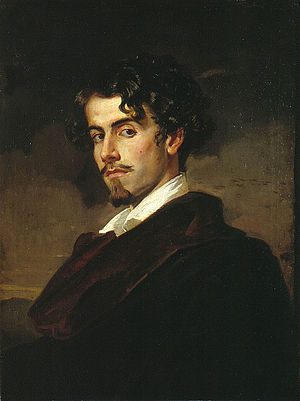
portrait of Gustavo Adolfo Bécquer (1836 – 1870), oil on canvas, 73 × 60cm (Photo credit: Wikipedia)
Biografía:
Gustavo Adolfo Domínguez Bastida nació en Sevilla el 17 de febrero de 1836 hijo del pintor José Domínguez Insausti, que firmaba con el nombre de sus antepasados (Bécquer, de origen flamenco). Su hermano Valeriano también adoptó el mismo apellido. Perdió a su padre cuando tenía cuatro años y a su madre cuando tenía diez y los dos hermanos quedaron a cargo de su tía materna. A los dos hermanos se les daba bien dibujar y pintar pero su hermano se dedicó a la pintura. Cuando la escuela a la que iba (el Colegio de San Telmo) fue suprimida fue a vivir con su madrina que tenía una gran biblioteca particularmente de poesía. También estudio pintura y dibujo. En 1854 fue a Madrid para intentar triunfar en la literatura. Decepcionada sobrevivió escribiendo bajo pseudónimo comedias y zarzuelas con dos amigos. En 1856 fue a Toledo con su hermano. Estaba interesado en aquella época por Byron y Heine.
En 1857 enferma de tuberculosis (algunos estudiosos han hablado de sífilis) y cuando se recupera decide escribir una Historia de los templos de España aunque solo llegó a publicarse el primer tomo.
En 1858 conoció a Josefina Espín y empezó a cortejarla aunque su hermana Julia (cantante de ópera) se convertiría en su musa. Entre 1859 y 1860 estuvo enamorado de una dama de Valladolid (no se sabe exactamente quién) que le abandonó y lo dejó desesperado. En 1861 se casó con Casta Esteban Navarro y tuvieron tres hijos aunque la relación fue difícil.
En 1860 publica Cartas literarias a una mujer donde explica sus Rimas. Un amigo, Rodríguez Correa le consigue trabajo de redactor en un nuevo diario, ‘El Contemporáneo’. Entre 1860 y 1865 escribió la mayor parte de sus Leyendas y Cartas desde mi celda.
Le nombran censor de novelas en 1866 y vuelve a Madrid, desempeñando el cargo hasta el 1868. Su mujer le es infiel (incluso parece que hubieron dudas sobre la paternidad de su tercer hijo) y su hermano y su esposa se discuten constantemente. Ella le abandona en 1868.
En 1870 va a Madrid para dirigir La Ilustración de Madrid, pero su hermano muere en Septiembre y nunca se recupera, muriendo el 22 de Diciembre, coincidiendo con un eclipse total de sol. (Inicialmente lo enterraron en Madrid aunque desde 1972 sus restos se hallan en el Panteón de Sevillanos Ilustres). En su lecho de muerte le pidió a su amigo y poeta Augusto Ferrán que quemase sus cartas y publicasen su obra.
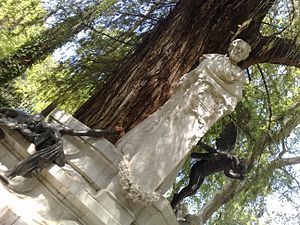
Español: Monumento a Gustavo Adolfo Bécquer en el Parque María Luisa de Sevilla. Vista frontal. (Photo credit: Wikipedia)
A su muerte un grupo de amigos responden a la propuesta del pintor Casado del Alisal de publicar sus obras. Organizaron una suscripción pública para honrarle y ayudar a su mujer e hijos. En 1871 se publicaron sus Obras Completas en dos volúmenes y en subsiguientes ediciones se añadieron más escritos.
Rimas:
LIII
Volverán las oscuras golondrinas
en tu balcón sus nidos a colgar,
y otra vez con el ala a sus cristales
jugando llamarán.
Pero aquellas que el vuelo refrenaban
tu hermosura y mi dicha a contemplar,
aquellas que aprendieron nuestros nombres…
¡esas… no volverán!.
Volverán las tupidas madreselvas
de tu jardín las tapias a escalar,
y otra vez a la tarde aún más hermosas
sus flores se abrirán.
Pero aquellas, cuajadas de rocío
cuyas gotas mirábamos temblar
y caer como lágrimas del día…
¡esas… no volverán!
Volverán del amor en tus oídos
las palabras ardientes a sonar;
tu corazón de su profundo sueño
tal vez despertará.
Pero mudo y absorto y de rodillas
como se adora a Dios ante su altar,
como yo te he querido…; desengáñate,
¡así… no te querrán!
RIMA XIII
Tu pupila es azul y, cuando ríes,
su claridad süave me recuerda
el trémulo fulgor de la mañana
que en el mar se refleja.
Tu pupila es azul y, cuando lloras,
las transparentes lágrimas en ella
se me figuran gotas de rocío
sobre una vïoleta.
Tu pupila es azul, y si en su fondo
como un punto de luz radia una idea,
me parece en el cielo de la tarde
una perdida estrella.
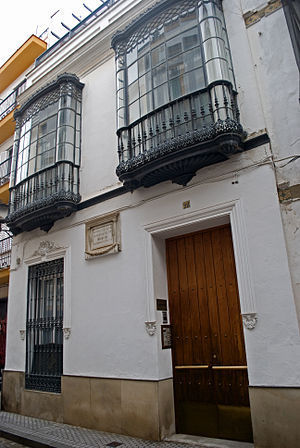
Español: Casa natal del poeta Gustavo Adolfo Bécquer en la actual calle de Conde de Barajas, Sevilla (Photo credit: Wikipedia)
RIMA XXX
Asomaba a sus ojos una lágrima
y a mi labio una frase de perdón;
habló el orgullo y se enjugó su llanto,
y la frase en mis labios expiró.
Yo voy por un camino; ella, por otro;
pero, al pensar en nuestro mutuo amor,
yo digo aún: —¿Por qué callé aquel día?
Y ella dirá: —¿Por qué no lloré yo?
RIMA VII
Del salón en el ángulo oscuro,
de su dueña tal vez olvidada,
silenciosa y cubierta de polvo
veíase el arpa.
¡Cuánta nota dormía en sus cuerdas
como el pájaro duerme en las ramas,
esperando la mano de nieve
que sabe arrancarlas!
¡Ay! pensé; ¡cuántas veces el genio
así duerme en el fondo del alma,
y una voz, como Lázaro, espera
que le diga: «¡Levántate y anda!».
(Qué razón llevaba)
RIMA XXXVIII
Los suspiros son aire y van al aire.
Las lágrimas son agua y van al mar.
Dime, mujer, cuando el amor se olvida,
¿sabes tú adónde va?
En honor a todos los poetas:
RIMA IV
No digáis que, agotado su tesoro,
de asuntos falta, enmudeció la lira;
podrá no haber poetas; pero siempre
habrá poesía.
Mientras las ondas de la luz al beso
palpiten encendidas,
mientras el sol las desgarradas nubes
de fuego y oro vista,
mientras el aire en su regazo lleve
perfumes y armonías,
mientras haya en el mundo primavera,
¡habrá poesía!
Mientras la ciencia a descubrir no alcance
las fuentes de la vida,
y en el mar o en el cielo haya un abismo
que al cálculo resista,
mientras la humanidad siempre avanzando
no sepa a dó camina,
mientras haya un misterio para el hombre,
¡habrá poesía!
Mientras se sienta que se ríe el alma,
sin que los labios rían;
mientras se llore, sin que el llanto acuda
a nublar la pupila;
mientras el corazón y la cabeza
batallando prosigan,
mientras haya esperanzas y recuerdos,
¡habrá poesía!
Mientras haya unos ojos que reflejen
los ojos que los miran,
mientras responda el labio suspirando
al labio que suspira,
mientras sentirse puedan en un beso
dos almas confundidas,
mientras exista una mujer hermosa,
¡habrá poesía!
Enlaces:
Generales
En los poetas (también enlace a sus obras, incluso algunas en formato MP3):
http://www.los-poetas.com/a/beq.htm
En Wikipedia:
http://es.wikipedia.org/wiki/Gustavo_Adolfo_B%C3%A9cquer
Poesías:
http://www.poesi.as/Gustavo_Adolfo_Becquer.htm
Biografías y vida:
http://www.biografiasyvidas.com/biografia/b/becquer.htm
Obras:
Selección de poemas:
http://www.poemas-del-alma.com/gustavo-adolfo-becquer.htm
Enlace a la página en la Biblioteca Cervantes con sus obras, incluyendo audios:
http://www.cervantesvirtual.com/bib/bib_autor/becquer/
Aquí Rimas y Leyendas al completo y cuentos sueltos:
http://www.ciudadseva.com/textos/cuentos/esp/becquer/gab.htm
Edición anotada de las Rimas:
http://cvc.cervantes.es/Obref/rimas/
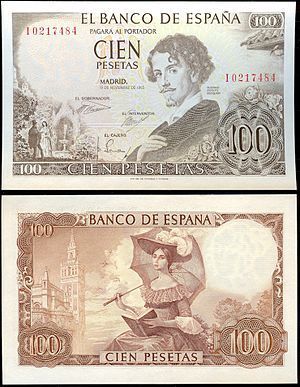
English: 100 pesetas of Spain 1965. This note was printed by FNMT dated 1965, though issued in 1970. This note has a portrait of Spanish poet Gustavo Adolfo Becquer(1836-1870) which was painted by his brother Valeriano. The lovely miss on the reverse with the parasol is a subject of one of his works. This hote is P-150. (Photo credit: Wikipedia)
Gracias por leer, y si os ha gustado, no os olvidéis de darle al me gusta, comentar, compartir, y hacer CLIC (¡que es gratis!). Y si tenéis sugerencias sobre autores clásicos a los que invitar, pues me las apunto también.








Guest classic author. Emily Dickinson
Guest Classic Author: Emily Dickinson
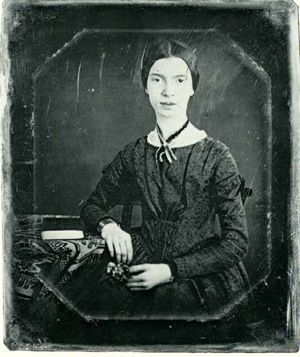
Emily Dickinson (Photo credit: Wikipedia)
As most Fridays, I bring you a guest author. This time is a classic, Emily Dickinson. I studied at Mount Holyoke (where famously Emily spent a year) and lived in the building named after her (that housed the Women’ Studies Department). I also visited her house in Amherst, a beautiful town and fascinating place. So although I was aware of her before, the proximity made me look into her work more closely. And I wanted to share it with you. As usual I’ll include a brief biography (Emily was a fairly reclusive character) and links and examples of her work. Also links where you can find more detailed information.
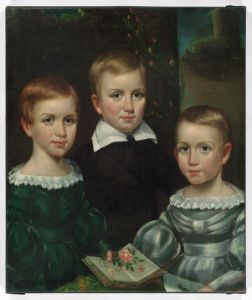
The Dickinson children (Emily on the left), ca. 1840. From the Dickinson Room at Houghton Library, Harvard University. (Photo credit: Wikipedia)
Biography:
Elizabeth Dickinson (December 10, 1830 – May 15, 1886) was born in Amherst (Massachusetts) of a family descending from the pilgrims’ times. Her paternal grandfather was one (the main) of the founders of Amherst College; her father was one of its treasurers and also served as State Legislator and representative of Hampshire district in Congress.
She had an older brother and a younger sister and her education was extensive for a girl of her time, attending Amherst Academy (for 7 years, somewhat interrupted due to ill health) and then Mount Holyoke College (briefly). She was described as a gifted musician and she had a good relationship with her father although not so good with her mother.
She seems to have been concerned and preoccupied by the deaths of those around her, including a female cousin, since she was fairly young, and that preoccupation accompanied her for the rest of her life.
A young lawyer who stayed with her family, Benjamin Franklin Newton, introduced her to the work of a variety of writers, including Wordsworth and Emerson, and he always thought of her as a poet. She was also influenced by Longfellow, Lydia Maria Child’s Letters from New York and Charlotte Brönte’s Jane Eyre.
She was very affected when the principal of Amherst Academy, and good friend, Leonard Humphrey, died at 25.
She was also good friends with Susan Gilbert, who later married her brother Austin, and who was her main correspondent.
In 1855 she visited Washington and Philadelphia with her mother, who later became bedridden, and Emily hardly left the house after that. In the late 1950s the family met Samuel Bowles, owner and editor of the Springfield Republican and he would later publish some of her poems and letters.
In the early 1860s she was very prolific and appears to have considered publication, but eventually did not come to pass. From 1866 she wrote far less and her behaviour started to change, hardly ever leaving the house. From 1867 she would talk to visitors through the door, although she continued to exchange letters and had good relationship with children. In the few occasions when she ventured outside of her house she dressed in white.
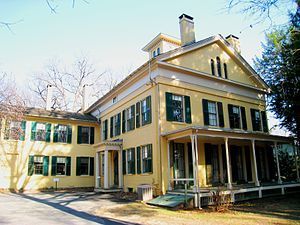
Emily Dickinson Museum, Amherst, Massachusetts – rear oblique view of Emily Dickinson’s house. (Photo credit: Wikipedia)
She studied botany and she was well known for her collection of plants.
Although she continued to write, she did not edit her work. The 1880s proved difficult, with her brother’s marriage breaking, her youngest nephew’s death and the death of her mother. In summer of 1884 she fainted while baking and did not recover for many hours. After that she was ill for weeks and never went back to health. In November 1885 she took to bed for several months and eventually on the 15th May 1886 she died of what was diagnosed as Bright’s disease (that the physician thought she had been suffering from for at least two and a half years).
Fewer than a dozen of her poems were published during her life and it was her sister who discovered her poems and got them published for the first time four years after her death.
Some poems:
“Faith” is a fine invention
When Gentlemen can see—
But Microscopes are prudent
In an Emergency.
*******************************************
“Hope” is the thing with feathers—
That perches in the soul—
And sings the tune without the words—
And never stops—at all—
And sweetest—in the Gale—is heard—
And sore must be the storm—
That could abash the little Bird
That kept so many warm—
I’ve heard it in the chillest land—
And on the strangest Sea—
Yet, never, in Extremity,
It asked a crumb—of Me.
*************************************
There is no frigate like a book
To take us lands away,
Nor any coursers like a page
Of prancing poetry.
This traverse may the poorest take
Without oppress of toll;
How frugal is the chariot
That bears a human soul!
*********************************
My life closed twice before its close;
It yet remains to see
If Immortality unveil
A third event to me,
So huge, so hopeless to conceive,
As these that twice befell.
Parting is all we know of heaven,
And all we need of hell.
*****************************
Because I could not stop for Death,
He kindly stopped for me;
The carriage held but just ourselves
And Immortality.
We slowly drove, he knew no haste,
And I had put away
My labor, and my leisure too,
For his civility.
We passed the school, where children strove
At recess, in the ring;
We passed the fields of gazing grain,
We passed the setting sun.
Or rather, he passed us;
The dews grew quivering and chill,
For only gossamer my gown,
My tippet only tulle.
We paused before a house that seemed
A swelling of the ground;
The roof was scarcely visible,
The cornice but a mound.
Since then ’tis centuries, and yet each
Feels shorter than the day
I first surmised the horses’ heads
Were toward eternity.
Links:
Wikipedia:
http://en.wikipedia.org/wiki/Emily_Dickinson
In poets’ organisation:
http://www.poets.org/poet.php/prmPID/155
Her electronic archive:
http://www.emilydickinson.org/
The Poetry Foundation:
http://www.poetryfoundation.org/bio/emily-dickinson
Goodreads page:
http://www.poetryfoundation.org/bio/emily-dickinson
Her museum:
http://www.emilydickinsonmuseum.org/
The Emily Dickinson International Society:
http://www.emilydickinsoninternationalsociety.org/
Links to her work:
http://www.poemhunter.com/emily-dickinson/
http://www.online-literature.com/dickinson/
In Amazon:
Poems Series 1
http://www.amazon.com/dp/B004TS1JMC/
Poems Series 2
http://www.amazon.com/dp/B004TS1HN8/
Poems Series 3
http://www.amazon.com/dp/B0084BXMS4/
And the three series in one:
http://www.amazon.com/dp/B0084BXPW2/
Related articles
Complete Emily Dickinson online archive goes live (telegraph.co.uk)
Monday Inspiration – Victorian Women Writers (susanmacatee.wordpress.com)
Writing Heroes: Emily Dickinson (wonderly.com)
The Online Emily Dickinson Archive Makes Thousands of the Poet’s Manuscripts Freely Available (openculture.com)
Book News: Emily Dickinson Papers Go Online, Deepening Harvard-Amherst Feud (npr.org)
Emily Dickinson, or the Rivalry of Harvard and Amherst (archivesmouse.wordpress.com)








November 18, 2013
Mantenerse en forma. Programas de ejercicios, apps gratuitos y perseverancia.
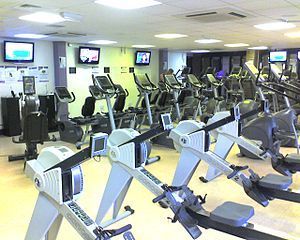
Fitness Suite (Photo credit: Wikipedia)
No es ningún secreto. La mayoría de gente aspira a conseguir y mantener un buen nivel de forma física. Es bueno para la salud, te hace sentirte mejor, y te ayuda a tener mejor aspecto. Cómo conseguirlo es otra historia.
Tengo que confesar que en cuanto a deportes soy un desastre. Ni siquiera se me da verlos en la tele (los que me gusta mirar son la gimnasia artística, la de los aparatos, no tanto la rítmica, y el patinaje artístico sobre hielo. Ha habido épocas de mi vida en que he visto mucho tenis, me gustaba John McEnroe en su época, me gustan los saltos de trampolín y palanca y el atletismo, especialmente los saltos con pértiga) y de pequeña estaba llenita (bueno, gorda) y era muy patosa (algunas cosas no cambian). Siempre tenía morados, arañazos, y si recordáis la mercromina, siempre iba decorada de guerra, especialmente las rodillas. La escuela se me daba bien aparte de la gimnasia y los deportes.
Siempre me ha encantado andar. Aunque no tengo tanta resistencia como tenía antes, yo me echaría a andar horas y horas si pudiera (y tuviera tiempo). Mi rodilla derecha no es lo que era así que ir en bicicleta no es lo mejor para mí. Puedo nadar (aunque no tengo muy buen estilo), pero mis cervicales también sufren así que no puedo nadar largas distancias.
Cuando estaba estudiando Medicina, una compañera y amiga, Carmen, que también vivía en la vecindad, sugirió que nos apuntáramos a un gimnasio. Me pareció una buena idea. Como suele pasarme muy a menudo, ella acabó por no apuntarse, y yo seguí yendo varios años, incluso cambiándome de gimnasio cuando el que solía ir se especializó en Kick-boxing. Siempre he preferido ir a clases (en aquella época aerobics) más que pesas o máquinas, no solo por el aspecto social, sino porque es más fácil motivarse y seguir motivado. Aunque yo soy bastante testaruda y cuando decido algo, normalmente sigo con ello hasta que decido que ya es hora de dejarlo.
Desde que emigré al Reino Unido he tenido épocas de todo con respecto al ejercicio, ya que me he mudado a menudo. Fui a un gimnasio grande cuando abrió cerca del primer hospital donde trabajé, en Eastbourne. Jugué a badminton (que se me da tan mal como todo lo demás, pero al menos corría algo con una de las otras doctoras), y fuí a variedad de clases. Luego de vez en cuando fuí a clases esporádicas, hice senderismo, etc… Los últimos diez años he sido miembro de varios gimnasios. He probado clases varias. Step (se me da muy mal lo que aquí llaman Step libre, ya que me lío fácilmente si me hacen dar muchas vueltas, pero algunas clases si que las puedo seguir), variedad de clases aeróbicas, pump (clases con pesas), combate (pegar patadas y puñetazos a oponentes no reales, aunque por supuesto te puedes imaginar a quien quieras), attaque (que es una versión modernizada e intensa del aerobic de toda la vida), aqua-aerobics (conseguí pegarle una patada a la pared de la piscina y me rompí un dedo del pie)… Hace poco, y ya que debido a mi problema con las cervicales no tolero bien las pesas, empecé a probar clases más de baile, como Shebam, Zumba, Jam. I también llevo haciendo yoga hace algo más de un año. Prefiero las clases más activas (ataque, combate) aunque de hecho lo que me gusta es la variedad.
Con mis planes para el futuro (que incluyen dejar mi trabajo y no tener una paga fija) he estado repasando las cosas que hago (y pago). Ser miembro de un gimnasio es bastante caro y luego también está el tiempo de ir y venir, y la gasolina (ya que no me cae lo suficientemente cerca de casa como para poder ir andando), así que decidir explorar otras opciones. Cuando haga buen tiempo, ir a andar, incluso correr (aunque no me gusta demasiado disfruto cuando voy a correr con mi amiga Iman en París), estoy pensando en investigar lo de la marcha nórdica (mi amiga Silvia, a la que conocí en el primer gimnasio al que me apunté, me dio buenas referencias). Descubrí que hay mucha gente que comparte programas de ejercicios en Pinterest y hay variedad de opciones y videos para probar en You Tube (a mí me gusta el Daily Hiit [Hiit: High Intensity Interval Training, Entrenamiento a intervalos de alta intensidad], aunque algunos de los programas da miedo solo con verlos, pero recientemente descargué Body Rock TV en mi teléfono, y he sobrevivido al reto de los 30 días de Lisa, con videos en tiempo real, que a pesar de que yo iba al gimnasio 5 o 6 veces por semana se me hizo muy duro). Entrenamiento a intervalos se lleva mucho y también ofrecen programas cortos para gente con poco tiempo (aunque se necesita mucha energía). También leí un blog que recomendaba una serie de Apps y ando probando ‘Nike Training Club’, que tiene algunas ventajas, como la de que no hace falta estar conectado a Wi-Fi para seguir el programa (aunque sí si quieres compartir), no necesitas mucho equipo, y te ofrece la opción de usar tu música favorita. (Sí, y es gratuito. El que comparto está recomendado para mujeres pero hay versión para hombre y tienen otros programas.) También estoy explorando videos de yoga, intentando encontrar los que me gusten más. Estoy alternando opciones diferentes, ahorro algo de tiempo y combustible. Ya veremos. No hay nada que se adapte a todo el mundo, pero hay mucha variedad, grupos locales, y no hay ninguna razón por la que no podamos alternar clases en la localidad con otras opciones. Lo importante es mantenerse activo.

Nordic Walking Miane (Photo credit: Nordic Walking Treviso)
Os dejo enlaces a lo que he comentado. Estos son específicamente de páginas de Web y Apps en inglés, pero estoy segura de que los habrá, y muchos en español. Y en You Tube desde luego hay de todo en todos los idiomas. Echadle un vistazo al Piloxing (Pilates+Boxin) si no me creéis.
http://www.nike.com/us/en_us/c/womens-training/apps/nike-training-club
Gracias por leer, y si os ha gustado, dadle al me gusta, comentad (y contadme que apps y videos usáis), compartid y si queréis hacer clic…pues eso.








Keeping Fit. Fitness regimes, free apps and keeping at it.
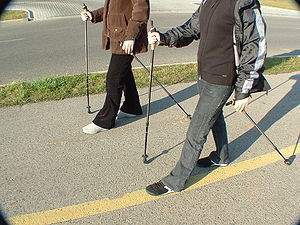
Nordic walking in Hungary (Photo credit: Wikipedia)
It’s no secret. Most of us aim to achieve and maintain a certain level of fitness. It’s good for your health, it helps your mood and makes you feel good, and it makes you look good. How to go about it is another story.
I must confess to being a disaster when it comes to sports. I’m not even good at watching them (truth be told I enjoy watching gymnastics and ice-skating. At some points in life I’ve been into tennis, I quite enjoy watching diving and some athletics) and as a child I was fairly big and very clumsy. I always sported bruises, grazes and all kind of injuries testimony to my lack of coordination. I was fairly good at school, except for PE.
I’ve always loved walking. Although I don’t have the stamina I had before, I quite happily go walking anywhere for hours on end. My right knee has seen better days and cycling is not a good option. I can swim (nothing fancy), but my neck is also problematic and can only do short bursts.
When I was in Medical School, one of my peers and friends, Carmen, who also lived nearby, suggested that we should join a gym. It seemed like a good idea. As it tends to happen to me very often, she ended up not joining, and I went for several years, even moving gyms when the one I was attending specialised in Kick Boxing. I’ve always preferred classes (aerobics at the time) rather than machines and your own programme, apart from the social aspect of it, because it’s easier to get motivated. Although I’m fairly stubborn, and if I decide to do something, normally I’ll keep going until I decide I’ve had enough.
Since I moved to the UK my attendance has varied as I’ve moved about a fair bit. I went to a David Lloyd Club when one open nearby the first hospital where I worked, in Eastbourne. I played badminton (no ability for that either but at least I ran around with a colleague a bit), and went to a variety of classes. Then at times I’ve joined the odd class, I’ve gone rambling, etc. For the last 10 years or so I’ve been a member of a variety of gyms. I’ve tried different classes. Step (I’m pretty bad at free step although can manage some classes if they aren’t too complicated), aerobic variety of classes, body pump (classes with weights), combat (kicking and punching a non-exiting opponent, although you’re free to imagine whoever you like), attack (high impact aerobics), aqua-aerobics (I managed to kick the pool and break a toe)… More recently and because due to my neck problems I can’t tolerate weights that much I tried some of the more dance-based lessons, like Jam, Shebam, Zumba, and I’ve been doing yoga for over a year. I prefer the more active classes (attack, combat) although probably it’s variety that I appreciate.
With my plans for the future (that would mean leaving my job and not having a regular income) I have been looking at the things I do. Membership of the gym is quite expensive and there’s the time factor, so I decided to try and explore other options. When the weather is good, more walking, even running (that I don’t like very much but enjoy when I visit my friend Iman in Paris), and thinking about checking Nordic walking (I’ve heard good things about it from Silvia, a friend I met at the first gym I joined). I discovered quite a few people sharing workouts and exercising regimes in Pinterest and there’s a wealth of different options and videos to try in You Tube (I quite like the Daily Hiit, [Hiit= high intensity interval training] although some of the workouts are scary just to watch, but I’ve recently downloaded Body Rock TV on the phone and survived to the 30 days fitness challenge, where Lisa shared real time workouts. I must say it’s a real challenge, especially considering that I was going to the gym 5 or 6 times a week and I suffered through it). Interval training is quite the thing these days and they offer short programmes for people with limited time (although you’ll need a fair amount of energy). I also read about other fitness apps and I’m now trying ‘Nike Training Club’, that has the advantage, especially if you’re travelling, of not relying much on equipment, not requiring Wi-fi connection (you’ll need it if you want to share, but not just to follow the workout), and giving you the option to use your favourite music. (Yes, and it’s FREE. The particular one I share is recommended for women but there are versions for men and others.) I’m also exploring the yoga videos and trying to find those I find suit me best. I’m alternating different things, I have a bit more time and I’m saving on fuel. But we’ll see. Nothing suits everybody but there’s a big variety of things available, of local groups, and no reason why one cannot alternate with local classes or anything else. The important thing is to keep active.
I leave you some links in case you want to check any of these:
http://www.nike.com/us/en_us/c/womens-training/apps/nike-training-club
Thanks for reading, I hope you enjoyed it, and if you have, please like, comment (and let me know of your favourites), share and if you want to know more you can always click and see.
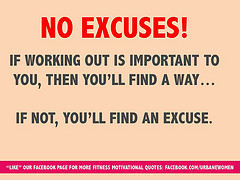
Fitness Motivation: No Excuses! (Photo credit: UrbaneWomenMag)
Related articles
Brickbat: Keeping Your Daughters off the Poles (ivoter.com)
Best Fitness Apps for Smartphone (dailytipsndtricks.blogspot.com)
Keeping Fit during Retirement (retireddoc40.wordpress.com)
GUEST POST: Revamp Your Exercise Regime in Five Simple Steps (wcman1976.wordpress.com)
Seen At 11: Is Your Favorite Fitness App Keeping Your Personal Info Secure? (newyork.cbslocal.com)
Best Fitness Apps for Smartphone! (freedomoffashionsandcouponcodes.wordpress.com)
Kick Start to Fitness (glowology.co.uk)








http://www.bloglovin.com/blog/1127664......
Author Translator Olga
En este blog hablo de la escritura y de mis libros, pero también reseño los libros de otros autores, comparto trucos, consejos, novedades literarias e ideas varias. Mi blog es bilingüe y comparto posts en español e inglés ...more
- Olga Núñez Miret's profile
- 250 followers


